Themed collection Electric vehicles and batteries

Constructing nitrided interfaces for stabilizing Li metal electrodes in liquid electrolytes
In this perspective, we make a systematic summary and give out our comments on constructing nitrided interfaces for stabilizing Li metal electrodes.

Chem. Sci., 2021,12, 8945-8966
https://doi.org/10.1039/D1SC01806J
Surface chemistry and structure manipulation of graphene-related materials to address the challenges of electrochemical energy storage
An overview of the strategies developed in our research to create graphene-based electrodes with better ionic conductivity, electron mobility, specific surface area, mechanical properties, and device performance than state-of-the-art electrodes.
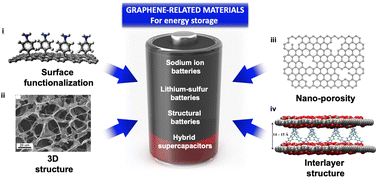
Chem. Commun., 2023,59, 2571-2583
https://doi.org/10.1039/D2CC06772B
Food waste valorization to green energy vehicles: sustainability assessment
Our work aims to identify critical factors that could become equally important in a coincident sustainability assessment of new green energy vehicle technologies with utilization of food waste as an alternative renewable resource to fossil fuels.

Energy Environ. Sci., 2021,14, 3651-3663
https://doi.org/10.1039/D1EE00850A
The advent of membrane-less zinc-anode aqueous batteries with lithium battery-like voltage
A 2.5 to 3.4 V Zn|MnO2 membrane-less solid-state battery accessing the 617 mA h g−1 theoretical capacity of MnO2 and its application in e-mobility is reported. This concept is made possible by a buffering layer that regulates the battery’s pH.

Mater. Horiz., 2022,9, 2160-2171
https://doi.org/10.1039/D2MH00280A
Ion correlation and negative lithium transference in polyelectrolyte solutions
We demonstrate that contrary to previous reports, transference number decreases with increasing degree of polymerization in non-aqueous lithium-bearing polyelectrolyte solutions that have been proposed as next-generation battery electrolytes.
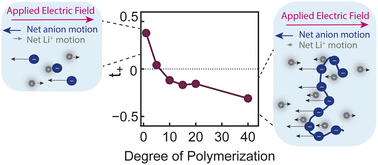
Chem. Sci., 2023,14, 6546-6557
https://doi.org/10.1039/D3SC01224G
Energy management strategy of a novel electric–hydraulic hybrid vehicle based on driving style recognition
Driving style is one of the typical factors that impact vehicle energy management during real-world vehicular operation.

Sustainable Energy Fuels, 2023,7, 420-430
https://doi.org/10.1039/D2SE01620F
Unravelling and quantifying the aging processes of commercial Li(Ni0.5Co0.2Mn0.3)O2/graphite lithium-ion batteries under constant current cycling
Constant current charging and discharging is widely used nowadays for commercial lithium (Li) ion batteries (LIBs) in applications of portable electronic devices and electric vehicles.
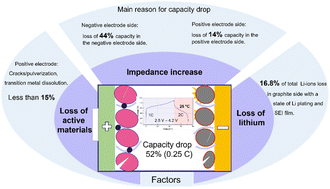
J. Mater. Chem. A, 2023,11, 41-52
https://doi.org/10.1039/D2TA05960F
Can vehicle-to-grid facilitate the transition to low carbon energy systems?
Vehicle-to-grid (V2G) allows electric vehicles to provide power and services to the grid. At scale, V2G can bolster renewable energy growth and eliminate storage and displace firm generators traditionally used to balance wind and solar intermittency.
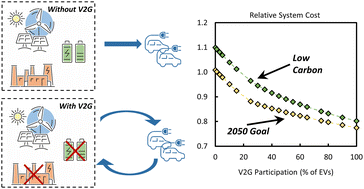
Energy Adv., 2022,1, 984-998
https://doi.org/10.1039/D2YA00204C
A shear-thickening colloidal electrolyte for aqueous zinc-ion batteries with resistance on impact
A bifunctional electrolyte was developed for aqueous zinc-ion batteries, which embeds impact resistance in the aqueous electrolyte and maintains a high-performance for full batteries.

Nanoscale, 2022,14, 14544-14551
https://doi.org/10.1039/D2NR04140E
Criteria and design guidance for lithium-ion battery safety from a material perspective
The ISC criteria at the component level which can provide guidance for battery safety design.
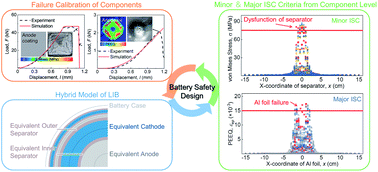
J. Mater. Chem. A, 2022,10, 6538-6550
https://doi.org/10.1039/D1TA09291J
Preventing lithium plating under extremes: an untold tale of two electrodes
Fast charging of lithium-ion cells is key to alleviate range anxiety and improve the commercial viability of electric vehicles, which is, however, limited by the propensity of lithium plating.

J. Mater. Chem. A, 2021,9, 17249-17260
https://doi.org/10.1039/D1TA05290J
External vibrations can destroy the specific capacitance of supercapacitors – from experimental proof to theoretical explanations
External vibrations can destroy the specific capacitance in supercapacitors. Carbon based supercapacitors show a higher ability to absorb the impacts of external vibrations, in comparison to metal oxide based pseudocapacitors.

J. Mater. Chem. A, 2021,9, 6460-6468
https://doi.org/10.1039/D0TA11794C
Self-supporting V2O5 nanofiber-based electrodes for magnesium–lithium-ion hybrid batteries
This work shows the feasibility of a self-supporting V2O5 nanofiber-based cathode for magnesium–lithium-ion batteries reaching an energy density of 280 W h kg−1.

RSC Adv., 2021,11, 1354-1359
https://doi.org/10.1039/D0RA10384E
About this collection
Electric vehicles are part of the answer to shift our reliance on fossil fuels. By improving electric vehicle range and battery life and reducing charge times, the speed of this transition will undoubtedly increase.
The chemical sciences community is already improving existing technologies. This collection of research showcases some of the innovative approaches to improving electric vehicles and battery technologies being tackled by teams around the world.